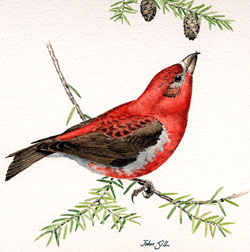Breeding Bird Atlases (BBA)
Find a Bird - BBA1
Breeding Bird Atlas 1 Species Accounts
Red Crossbill
Loxia curvirostra
Egg Dates
March 18 to April 1
Number of Broods
one

The unpredictable movements of the Red Crossbill make it difficult to determine the species’ status in any given region or to define regular breeding areas throughout its nearly circumboreal range. In Massachusetts, breeding has been confirmed only a handful of times. There are several Essex County reports, and Bent mentions a nest from the Berkshires. Most records of crossbills during the Atlas project were from the northern Berkshires, a region that holds promise for regular breeding due to the larger percentage of Red and Black spruce, Balsam Fir, American Larch, and Eastern Hemlock, all preferred trees for feeding. The one confirmed Atlas nest was in the pine-oak barrens of Plymouth. Occasionally, streaked juveniles appear at feeders with adults in May or June. Although these may have been reared locally, there is always the possibility that they have wandered from other areas.
Although Red Crossbills are known to nest at virtually any time during the year, a clear majority of birds breed from February through April regardless of latitude. The song is usually a short series of single notes followed by a few two-syllable phrases, the latter notes somewhat higher pitched on the second syllable. These short songs can be given a few together or many in rapid succession, the effect being one, long, elaborate performance. Males sing from perches and also give a flight song while circling with fluttering wings. The common call note is a kip or yip.
The nest is usually placed in a conifer 10 to 40 feet above the ground. Old man’s beard lichen is often a component, along with twigs and fine grass. A nest at Eastern Point in Gloucester was constructed exclusively by a female from March 2 to March 13 (Snyder 1952). Generally, three or four eggs are laid, and the female incubates for about two weeks. During this period and for the first days after the young hatch, the male feeds the female on the nest. The young fledge in about 17 days. The Gloucester nest contained eggs from March 18 to April 1, and hatching occurred on April 2 (Snyder 1952). The annual molt is believed to occur in September, which, given the peripatetic nature of the species, may be either before, during, or after an individual’s travels.
Nothing is known about the movements of a given pair or family group following the nesting cycle. Considerable postbreeding wandering may take place, and this leads to most reports of “summering” birds in Massachusetts. The appearance of crossbills in August does not necessarily signal the vanguard of a wintering population. State records are most frequent in September, October, and November.
Red Crossbills feed on a variety of coniferous and deciduous tree seeds, as well as buds and insects. In most years, comparatively short movements (perhaps several in a season) are sufficient for the birds to find adequate food. Occasionally, large numbers of crossbills invade the state, remaining through most of the winter. It is believed that this occurs when food supplies involving several favored tree species fail over a wide region of the crossbills’ northern stronghold. During their stay, flocks may become highly sedentary as they systematically exploit the pines, hemlocks, and spruces of a local area, sometimes allowing an observer to approach within a few feet. Much about the biology of this opportunistic species remains an ornithological puzzle.
Map Legend and Data Summary
Atlas 1 data collected from 1975-1979


Note: rare and sporadic breeder, often following flight years; prefers conifers
Bruce A. Sorrie



